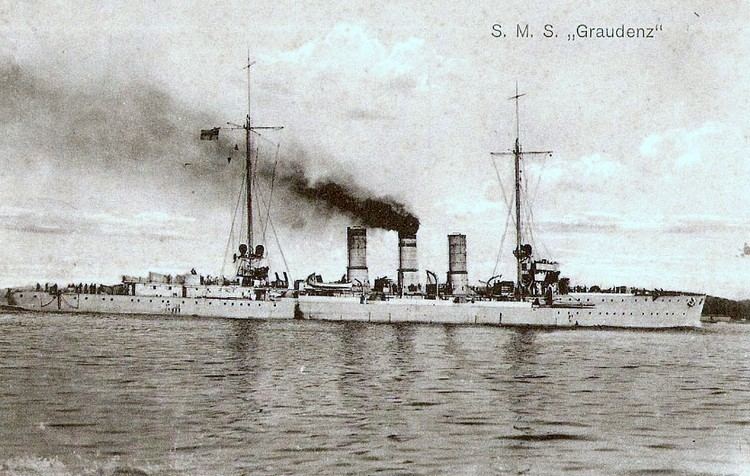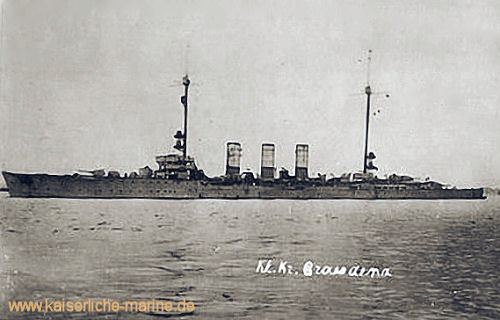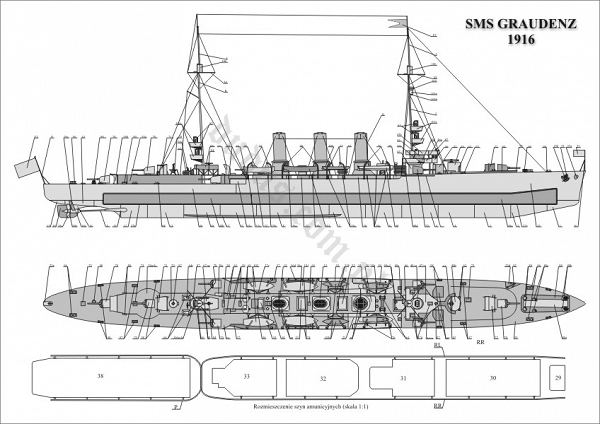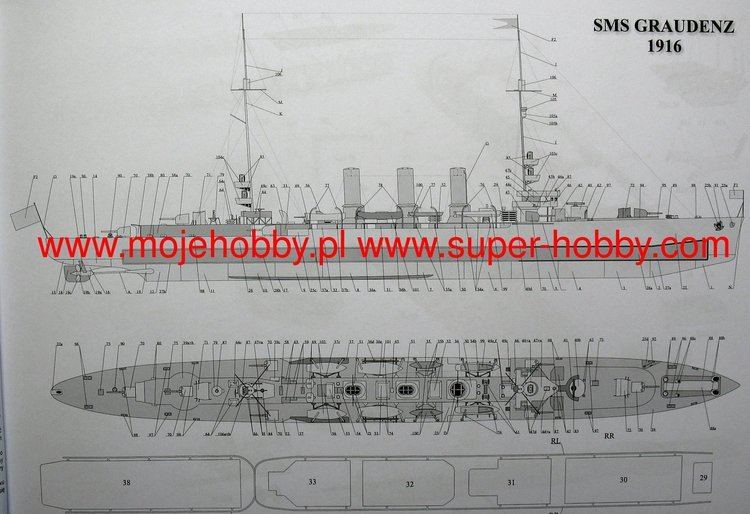Name Graudenz Laid down 1912 Struck 10 March 1920 Construction started 1912 Length 143 m | Namesake City of Graudenz Commissioned 10 August 1914 Fate Ceded to Italy in 1920 Launched 25 October 1913 Beam 14 m | |
 | ||
Sms graudenz
SMS Graudenz was the lead ship of her class of light cruisers. She had one sister ship, SMS Regensburg. The ship was built by the German Kaiserliche Marine (Imperial Navy) in the Kaiserliche Werft shipyard in Kiel, laid down in 1912 and commissioned into the High Seas Fleet in August 1914, days after the outbreak of World War I. She was named for the then-German town of Graudenz (now Grudziądz, Poland). The ship was armed with a main battery of twelve 10.5 cm SK L/45 guns and had a top speed of 27.5 knots (50.9 km/h; 31.6 mph).
Contents

Graudenz saw extensive service during World War I, including serving as part of the reconnaissance screen for the battlecruisers of the I Scouting Group during the raid on Scarborough, Hartlepool and Whitby in December 1914. The ship also took part in the Battle of Dogger Bank in January 1915, and the Battle of the Gulf of Riga in August 1915. She had been damaged by a mine and was unable to participate in the Battle of Jutland in May 1916. She was assigned to the planned final operation of the High Seas Fleet in October 1918, weeks before the end of the war, but a major mutiny forced the cancellation of the plan. After the end of the war, the ship was ceded to Italy as a war prize and commissioned into the Italian Navy as Ancona; she remained in service until 1937 when she was stricken and broken up for scrap.

Design

Graudenz was ordered under the contract name "Ersatz Prinzess Wilhelm" and was laid down at the Kaiserliche Werft shipyard in Kiel in 1912 and was launched on 25 October 1913. At her launch, the mayor of Graudenz, Dr. Kühnast, christened the ship. She was commissioned into the High Seas Fleet on 10 August 1914. The ship was 142.7 meters (468 ft) long overall and had a beam of 13.8 m (45 ft) and a draft of 5.75 m (18.9 ft) forward. She displaced 6,382 t (6,281 long tons; 7,035 short tons) at full combat load. Her propulsion system consisted of two sets of Marine steam turbines driving two 3.5-meter (11 ft) propellers. They were designed to give 26,000 shaft horsepower (19,000 kW). These were powered by ten coal-fired Marine-type water-tube boilers and two oil-fired double-ended boilers. These gave the ship a top speed of 27.5 knots (50.9 km/h; 31.6 mph). Graudenz carried 1,280 t (1,260 long tons) of coal, and an additional 375 t (369 long tons) of oil that gave her a range of approximately 5,500 nautical miles (10,200 km; 6,300 mi) at 12 knots (22 km/h; 14 mph). She had a crew of 21 officers and 364 enlisted men.

The ship was armed with twelve 10.5 cm SK L/45 guns in single pedestal mounts. Two were placed side by side forward on the forecastle, eight were located amidships, four on either side, and two in a superfiring pair aft. The guns had a maximum elevation of 30 degrees, which allowed them to engage targets out to 12,700 m (41,700 ft). These were later replaced with seven 15 cm SK L/45 guns and two 8.8 cm SK L/45 anti-aircraft guns. She was also equipped with a pair of 50 cm (19.7 in) torpedo tubes with five torpedoes submerged in the hull on the broadside. Two deck-mounted launchers were added when the gun armament was upgraded. She could also carry 120 mines. The ship was protected by a waterline armored belt that was 60 mm (2.4 in) thick amidships. The conning tower had 100 mm (3.9 in) thick sides, and the deck was covered with up to 60 mm thick armor plate.
Service history

Graudenz's first operation was the raid on Yarmouth on 3 November 1914. She formed part of the reconnaissance screen for the battlecruisers of Rear Admiral Franz von Hipper's I Scouting Group, along with the cruisers Kolberg and Strassburg. The bombardment was conducted without incident, but on the return, the armored cruiser Yorck struck a German mine outside Wilhelmshaven and sank. She was also present for the raid on Scarborough, Hartlepool and Whitby on 15–16 December 1914. After completing the bombardment of the towns, the Germans began to withdraw, though British forces moved to intercept them. Graudenz, Stralsund, Strassburg, and two flotillas of torpedo boats steamed between two British squadrons. In the heavy mist, which reduced visibility to less than 4,000 yd (3,700 m), only Stralsund was spotted, though only briefly. The Germans were able to use the bad weather to cover their withdrawal. Graudenz again screened for the I Scouting Group for the sortie out to the Dogger Bank on 24 January 1915. In the ensuing Battle of Dogger Bank, the large armored cruiser Blücher was sunk.

In August 1915, Graudenz went into the Baltic for a major operation to clear the Gulf of Riga of Russian naval forces. Eight dreadnoughts and three battlecruisers from the High Seas Fleet were detached for the operation. Graudenz participated in the second attack on 16 August, led by the dreadnoughts Nassau and Posen. The minesweepers cleared the Russian minefields by the 20th, allowing the German squadron to enter the Gulf. The Russians had by this time withdrawn to Moon Sound, and the threat of Russian submarines and mines in the Gulf prompted the Germans to retreat. The major units of the High Seas Fleet were back in the North Sea before the end of August. Graudenz struck a mine in mid 1916, and was in drydock for repairs in May 1916. As a result, she was unavailable for the fleet operation that resulted in the Battle of Jutland on 31 May − 1 June 1916. For the remainder of the war, she served as a torpedo boat flotilla leader.
By October 1918, Graudenz was assigned to the II Scouting Group, which was to participate in a final, climactic attack by the High Seas Fleet. The planned operation called for raids on Allied shipping in the Thames estuary and Flanders to draw out the Grand Fleet. Graudenz, Karlsruhe and Nürnberg were assigned to the force tasked with attacking Flanders. On the morning of 29 October 1918, the order was given to sail from Wilhelmshaven the following day. Starting on the night of 29 October, sailors on Thüringen and then on several other battleships mutinied. The unrest ultimately forced Hipper and Scheer to cancel the operation. Commodore Andreas Michelsen organized a force of light craft, including light cruisers, destroyers, and U-boats to oppose a possible British attack while the heavy units of the fleet were in disarray; he chose Graudenz as his flagship.
Italian service
Graudenz served with the newly reorganized Reichsmarine in the aftermath of the war, through 1919. She was stricken from the naval register on 10 March 1920 and surrendered to the Allies as a war prize. She was transferred to Italy on 1 June 1920 under the name "E" in the French port of Cherbourg. She was placed in Italian service and renamed Ancona. She was overhauled starting in 1921 through 1924, during which she was partially re-boilered with six oil-fired models, and the remaining six boilers were modified to allow coal or oil burning. Her coal storage space was reduced from 1,280 t (1,260 long tons; 1,410 short tons) to 900 metric tons (890 long tons; 990 short tons) and her oil bunker capacity was correspondingly increased from 375 t (369 long tons; 413 short tons) to 1,520 t (1,500 long tons; 1,680 short tons).
Ancona was commissioned into the Italian Navy on 6 May 1925. She was modified extensively in 1928–1929, during which a fixed aircraft catapult was installed in the bow. The modifications required a longer bow to fit the catapult, so a longer clipper bow was installed. This was to test the utility of a fixed catapult on the bow, an arrangement that would later be used in the Trento and Zara classes of heavy cruisers built in the 1920s and 1930s. Ancona thereafter served in secondary roles until 1932 when she was placed in reserve in Taranto. She was stricken on 11 March 1937 and was retained for some time as a source of spare parts for the other two ex-German cruisers in Italian service, Bari and Taranto. Ancona was eventually broken up for scrap by hte end of the 1930s.
